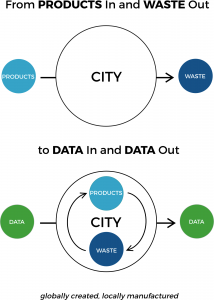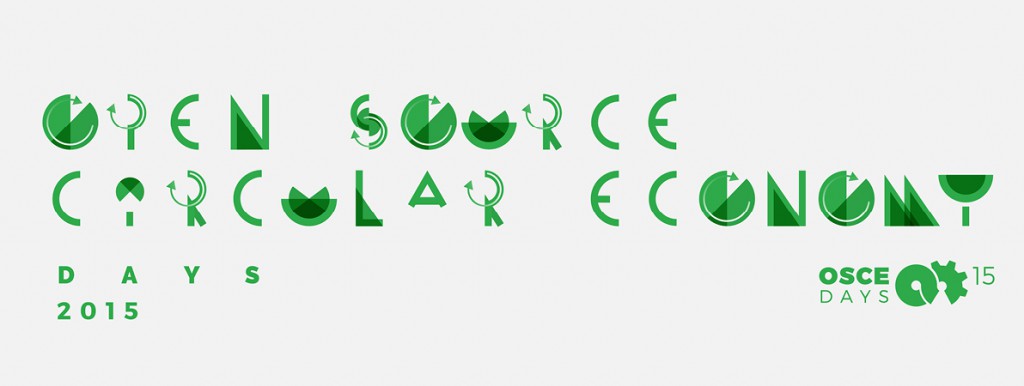From „Products In & Waste Out“ to „Data In & Data Out“
A while ago i stumbled over a great documentary by Tristan Copley Smith and Sam Muirhead about the FAB10 conference in Barcelona and fab labs in general (video embedded below). From this documentary I learned a great model that seems to come from Neil Gershenfeld – the inventor of the fab lab-concept.
The framing idea for the model is that in the future fab labs will be everywhere and play a huge role in how we produce our goods.
„A fab lab (fabrication laboratory) is a small-scale workshop offering (personal) digital fabrication.A fab lab is generally equipped with an array of flexible computer controlled tools [… like 3d printers, CNC machines …] with the aim to make „almost anything“. [Wikipedia]
The fab lab scene is growing quickly. In the future we will go from fab labs to fab cities. Instead of atoms (products) travelling around the world just bits (data) will be travelling, the manufacturing of the physical goods will happen locally.
Our cities are in a shift (and here comes the model):
From PRODUCTS IN & WASTE OUT to DATA IN & DATA OUT
I really like that model! I can think of all sorts of data streams coming in and going out and doing that job (the constant refurbishing and recycling there in the middle!), but almost all of them require full transparency and openness on the level of products and waste- as well as resource-streams!
Join us at the OSCEdays and help us to discover the details of and the stepping stones towards: From PRODUCTS IN & WASTE OUT to DATA IN & DATA OUT.
–
S O M E V I D E O S
For you to get more into the field:
FAB10 Docu:
OSVehicle Spot:
OSVehicle is one of the open-source-car-projects in the world and they made this amazing video explaining the possibilities of open source for the Data In & Data Out concept.
Neil Gershenfeld TED:
This is a 2006 (!) TED talk by Neil Gershenfeld about the fab lab-concept. Its almost 10 years old but still sounds like from the future. It will take us years to understand all the implications made, I guess. Truly great.
+
Image: by me (Lars Zimmermann), CC-BY-SA
+ +
I like to give credit to Simone Cicero (@meedabyte) and this blogpost of him that I recommend also as further reading!
.
. . .
/* deutsch */
Von _Produkte rein und Müll raus > zu _Daten rein und Daten raus >
Vor einer Weile bin ich auf diese großartige Dokumentation gestoßen von Tristan Copley Smith und Sam über die FAB10 Konferenz in Barcelona und FabLabs generell (Video oben eingebettet). Die Dokumentation enthält ein interessantes Model, welches von Neil Gershenfeld – dem Erfinder des Fablab-Konzeptes – zu stammen scheint.
Die Rahmenidee für das Model ist, dass in der Zukunft FabLabs überall verbreitet sein werden und eine große Rolle bei der Produktion der Güter unseres täglichen Bedarfs spielen werden.
“Ein FabLab (engl. fabrication laboratory – Fabrikationslabor) ist eine offene, demokratische High-Tech-Werkstatt mit dem Ziel, Privatpersonen industrielle Produktionsverfahren für Einzelstücke zur Verfügung zu stellen. Werkstätten mit digitalen Fertigungsmaschinen die „fast alles herstellen können“ („make almost everything“).“ [Wikipedia]
Die FabLab-Szene wächst sehr schnell. Und in der Zukunft werden wir von FabLabs zu FabStädten (fab cities) kommen. Nicht Atome (Produkte & Müll) werden mehr um die Welt reisen, sondern nur noch Bits (Daten); die Produktion der physischen Güter geschieht vor Ort.
Unsere Städte sind in einem Wandel (und hier kommt das Model):
Von PRODUKTE rein und MÜLL raus zu DATEN rein und DATEN raus
Ich mag das Model! Mir fallen viele Arten von Daten ein, die herein- und herausströmen können und das permanente Aufbereiten und Recycling von physischen Produkten in der Stadt erlauben, aber fast alle davon setzen volle Transparenz und Offenheit bei den Produkten und den Müll- sowie Ressourcenströmen voraus!
Das Model hat viele Verbindungen zu unserem Konzept einer Open Source Kreislaufwirtschaft, welches wir mit den Open Source Circular Economy Days 2015 zur Diskussion bringen werden.
Nehmt an den OSCEdays teil und helft uns, die Details des Models und Schritte hin zu seiner Verwirklichung zu entdecken. „Von Produkte rein und Müll raus zu Daten rein und Müll raus“ von einem abstrakten Model zu einem sich entwickelnden Teil unserer Wirklichkeit werden zu lassen!
V I D E O S
Oben gibt es eingebettet einige Videos, um sich dem Feld weiter anzunähern.
^ ^
*|– v –|*
°°


